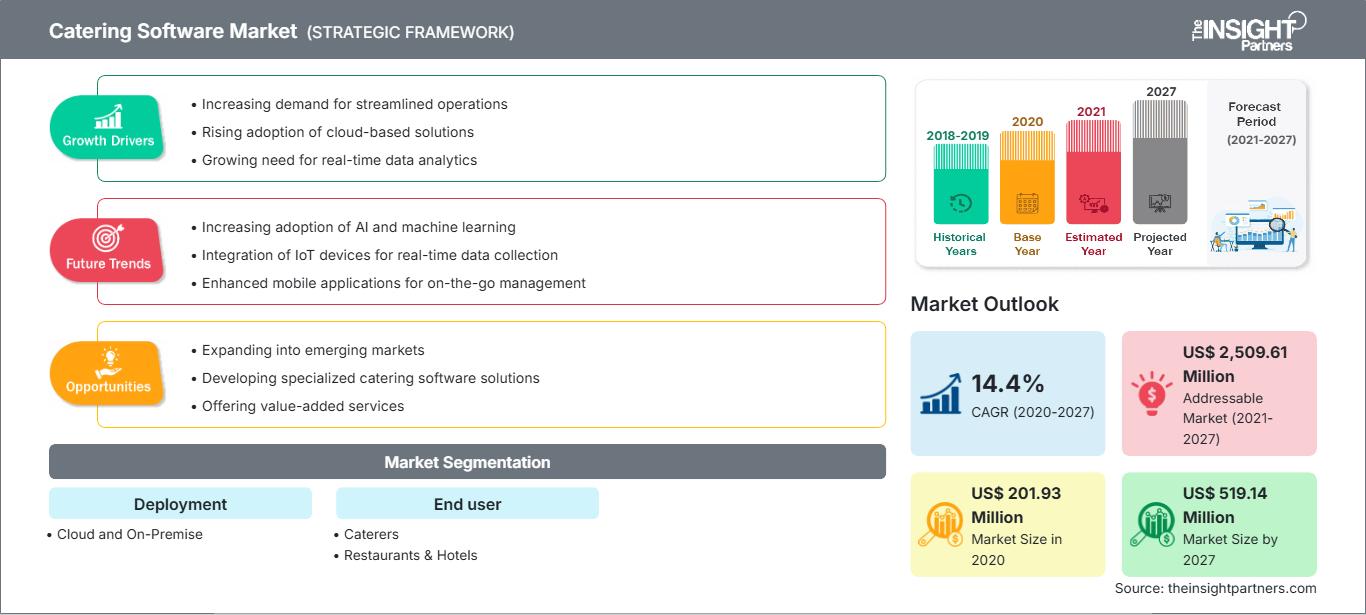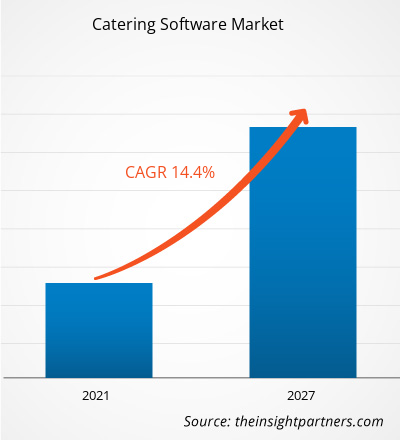Le marché des logiciels de restauration devrait passer de 201,93 millions de dollars US en 2020 à 519,14 millions de dollars US en 2027 ; sa croissance est estimée à un TCAC de 14,4 % entre 2020 et 2027.
L'analyse du Big Data, qui vise à améliorer les opérations de restauration, contribue à la croissance du marché. Cette technologie présente un potentiel considérable pour transformer radicalement le secteur de la restauration. L'adoption de solutions Big Data contribue à améliorer l'efficacité des réseaux de distribution et de production dans l'ensemble du secteur de la restauration. Cette technologie permet de suivre l'ensemble du processus de transport des fournitures. Grâce à des informations en temps réel, les clients peuvent suivre leurs commandes sur leurs appareils et vérifier l'état de la restauration. L'intégration d'un tableau de bord d'analyse dans les logiciels de restauration permet de suivre et d'évaluer les performances des agents de restauration. De plus, chaque acteur du secteur de la restauration doit disposer de données pertinentes sur ses produits, notamment celles relatives aux agriculteurs, aux expéditeurs et aux détaillants, en passant par les restaurants et les magasins. Par exemple, le restaurant KFC utilise des outils Big Data pour analyser les retours clients et leurs préférences alimentaires, ce qui améliore l'expérience client, les ventes et les bénéfices.
Le secteur du e-commerce, toutes régions confondues, a connu de nombreuses transformations ces dernières années ; sa croissance a incité les acteurs du marché des logiciels de restauration à exploiter l'analyse Big Data pour prendre des décisions commerciales plus éclairées. Cette technologie permet aux e-commerçants d'évaluer les interactions clients sur différents canaux, tels que les appareils mobiles, les réseaux sociaux et les sites web.
Personnalisez ce rapport en fonction de vos besoins
Vous bénéficierez d’une personnalisation sur n’importe quel rapport - gratuitement - y compris des parties de ce rapport, ou une analyse au niveau du pays, un pack de données Excel, ainsi que de profiter d’offres exceptionnelles et de réductions pour les start-ups et les universités
Marché des logiciels de restauration: Perspectives stratégiques

- Obtenez les principales tendances clés du marché de ce rapport.Cet échantillon GRATUIT comprendra une analyse de données, allant des tendances du marché aux estimations et prévisions.
Impact de la pandémie de COVID-19 sur le marché des logiciels de restauration
Vous bénéficierez d’une personnalisation sur n’importe quel rapport - gratuitement - y compris des parties de ce rapport, ou une analyse au niveau du pays, un pack de données Excel, ainsi que de profiter d’offres exceptionnelles et de réductions pour les start-ups et les universités
Marché des logiciels de restauration: Perspectives stratégiques

- Obtenez les principales tendances clés du marché de ce rapport.Cet échantillon GRATUIT comprendra une analyse de données, allant des tendances du marché aux estimations et prévisions.
Suite à l'épidémie mondiale de COVID-19, certaines entreprises ont été contraintes de réduire leurs activités en raison des diverses mesures de confinement mises en place par les gouvernements du monde entier. La propagation rapide du virus a incité les gouvernements du monde entier à imposer des restrictions strictes à la circulation des personnes et des véhicules. Les entreprises qui dépendent des interactions physiques pour générer des revenus ont été gravement touchées par les confinements. Par conséquent, certaines entreprises se concentrent sur l'augmentation des conversions, des interactions et des revenus via les médias numériques.
Analyses du marché : Le marché des logiciels de restauration : l'apprentissage automatique va révolutionner le secteur de la restauration
Dans le secteur de la restauration, l'insuffisance de la cartographie des zones et le déséquilibre entre la demande et la disponibilité des ressources entraînent plusieurs défis. L'apprentissage automatique et l'intelligence artificielle (IA) sont les fondements des technologies de restauration de nouvelle génération. Ces technologies permettent aux systèmes d'apprendre à partir de données enregistrées, qui comprennent des algorithmes, des modèles et des informations prédictives. Plusieurs entreprises de livraison de repas en ligne adoptent l'apprentissage automatique pour améliorer leur activité de restauration et accroître leur efficacité. Par exemple, Deliveroo, une entreprise de livraison de repas basée au Royaume-Uni, investit dans des technologies de pointe comme l'apprentissage automatique pour rester compétitive sur le marché en offrant un service de livraison de repas plus efficace. Glovo, une entreprise de livraison de repas basée en Espagne, utilise également l'apprentissage automatique pour prévoir la probabilité de rester actif sur l'application. Ainsi, l'intégration de l'apprentissage automatique dans les entreprises de restauration devrait stimuler la demande de logiciels de restauration au cours de la période de prévision.
Informations basées sur le déploiement
Selon le type de déploiement, le marché des logiciels de restauration est segmenté en cloud et sur site. Le segment cloud détenait la plus grande part de marché en 2019.
Marché des logiciels de restauration
Les tendances régionales et les facteurs influençant le marché des logiciels de restauration tout au long de la période de prévision ont été analysés en détail par les analystes de The Insight Partners. Cette section aborde également les segments et la répartition géographique du marché des logiciels de restauration en Amérique du Nord, en Europe, en Asie-Pacifique, au Moyen-Orient et en Afrique, ainsi qu'en Amérique du Sud et en Amérique centrale.
Portée du rapport sur le marché des logiciels de restauration| Attribut de rapport | Détails |
|---|---|
| Taille du marché en 2020 | US$ 201.93 Million |
| Taille du marché par 2027 | US$ 519.14 Million |
| TCAC mondial (2020 - 2027) | 14.4% |
| Données historiques | 2018-2019 |
| Période de prévision | 2021-2027 |
| Segments couverts |
By Déploiement
|
| Régions et pays couverts | Amérique du Nord
|
| Leaders du marché et profils d'entreprises clés |
|
Densité des acteurs du marché des logiciels de restauration : comprendre son impact sur la dynamique des entreprises
Le marché des logiciels de restauration connaît une croissance rapide, porté par une demande croissante des utilisateurs finaux, due à des facteurs tels que l'évolution des préférences des consommateurs, les avancées technologiques et une meilleure connaissance des avantages du produit. Face à cette demande croissante, les entreprises élargissent leur offre, innovent pour répondre aux besoins des consommateurs et capitalisent sur les nouvelles tendances, ce qui alimente la croissance du marché.
- Obtenez le Marché des logiciels de restauration Aperçu des principaux acteurs clés
Les acteurs opérant sur le marché des logiciels de restauration se concentrent principalement sur le développement de produits avancés et efficaces.
- En 2020, CaterZen a investi des heures de programmation depuis début mars pour confirmer que les restaurants et les traiteurs peuvent poursuivre leurs activités en se concentrant fortement sur les commandes en ligne et la livraison de nourriture.
- En 2020, Flex Catering a lancé le KDS (Kitchen Display System) de restauration, un type d'écran numérique qui remplace les commandes imprimées ou manuscrites dans les restaurants et les entreprises alimentaires.
Le marché des logiciels de restauration a été segmenté comme suit : Logiciels de restauration mondiaux - Par déploiement
- Cloud
- Sur site
Logiciels de restauration mondiaux - Par utilisateur final
- Traiteurs
- Restaurants et Hôtels
- Autres
Marché mondial des logiciels de restauration – par géographie
Amérique du Nord
- États-Unis
- Canada
- Mexique
Europe
- France
- Allemagne
- Italie
- Russie
- Royaume-Uni
- Reste de l'Europe
Asie Pacifique (APAC)
- Japon
- Chine
- Australie
- Inde
- Corée du Sud
- Reste de l'APAC
Moyen-Orient et Afrique (MEA)
- Arabie Saoudite
- ÉAU
- Afrique du Sud
- Reste du MEA
Sud Amérique (SAM)
- Brésil
- Argentine
- Reste de SAM
Marché des logiciels de restauration - Profils d'entreprises
- Aptus Systems Ltd.
- Better Cater, Inc
- Caterease Software
- CaterTrax, Inc.
- CaterZen par Restaurant & Catering Systems
- Flex Catering
- FoodStorm Catering Software (CaterXpress)
- Planning Pod (My Wedding Workbook, LLC)
- Profit Systems Inc.
- Pxier
- Analyse historique (2 ans), année de base, prévision (7 ans) avec TCAC
- Analyse PEST et SWOT
- Taille du marché Valeur / Volume - Mondial, Régional, Pays
- Industrie et paysage concurrentiel
- Ensemble de données Excel
Rapports récents
Rapports connexes
Témoignages
Raison d'acheter
- Prise de décision éclairée
- Compréhension de la dynamique du marché
- Analyse concurrentielle
- Connaissances clients
- Prévisions de marché
- Atténuation des risques
- Planification stratégique
- Justification des investissements
- Identification des marchés émergents
- Amélioration des stratégies marketing
- Amélioration de l'efficacité opérationnelle
- Alignement sur les tendances réglementaires




















 Obtenez un échantillon gratuit pour - Marché des logiciels de restauration
Obtenez un échantillon gratuit pour - Marché des logiciels de restauration